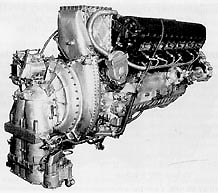










RSR Pro 1000 PSI Turbo Water Injection
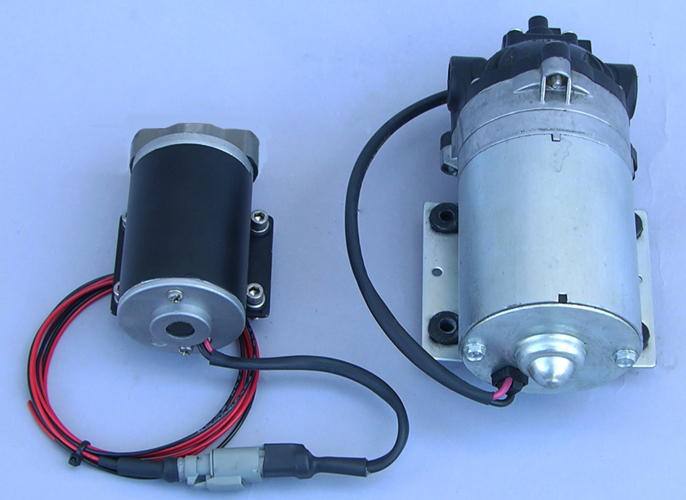
It's
the pumps. It's always the pumps. They can never be too
small or too
powerful, or, as they say, too rich or too thin. Usually
they are fat
and noisy or small and pitiful in their output. When they
are fat and
noisy and only come in one size they, most likely, are
diaphragm pumps
that crawled out of
bilges on boats
or escaped from agricultural spray systems.
Our
high pressure pump pictured above to the left is small, is
1/3 the
weight,
and runs up to six times the pressure of the typical water
injection
kit pump pictured on the right. Higher pressures means far
better
atomization. It draws less that 3 amps @ 1000 psi.
Before we show you how we
do this you need to know a bit about water injection's
history and
about RB Racing's history using water injection. Part
numbers and
pricing are listed below.
Part Numbers, Flow and Horsepower Ratings & Number
of
Nozzles
RSR Pro
1000 PSI
Water Injection System
|
Description
|
Nozzles 90
degree
1/4" NPT
|
Hardware:
Note: Does not include any reservoir.
|
2500 PSI Hose
|
Price
|
03-1001
|
160cc's
/ minute
300 hp:
12% Water to Fuel Ratio
1000 psi operation
Dual Nozzles
3.5 Amp electrical load
|
Two (2) "B"
Nozzles with anti-vacuum
valve and filter
90 degree 1/4" NPT
|
Pump; hose fittings; 30A
Relay;
Hobbs Pressure Switch; On/Off Switch; Wiring; LED
acivation light; Two B nozzles. |
8 feet 2500 psi hose
|
$695.00
|
03-1002
|
180cc's
/ minute
350 hp:
12% Water to Fuel Ratio
1100 psi operation
One Nozzle
3 Amp electrical load
|
One (1) "D"
Nozzle with anti-vacuum
valve and filter
90 degree 1/4" NPT
|
Pump; hose fittings; 30A
Relay;
Hobbs Pressure Switch; On/Off Switch; Wiring; LED
acivation light; One D nozzle |
8 feet 2500 psi hose
|
$650.00
|
03-1003
|
180cc's
/ minute
350 hp:
12% Water to Fuel Ratio
1000 psi operation
Dual Nozzles
4.0 Amp electrical load
|
Two (2) "A"
Nozzles with anti-vacuum
valve and filter
90 degree 1/4" NPT
|
Pump; hose fittings; 30A
Relay;
Hobbs Pressure Switch; On/Off Switch; Wiring; LED
acivation light; Two A nozzles. |
8 feet 2500 psi hose
|
$695.00
|
03-1004
|
200cc's
/ minute
375hp:
12% Water to Fuel Ratio
780 psi operation
Dual Nozzle
3.0 Amp electrical load
|
Two (2) "C"
Nozzles with anti-vacuum
valve and filter
90 degree 1/4" NPT
|
Pump; hose fittings; 30A
Relay;
Hobbs Pressure Switch; On/Off Switch; Wiring; Two C
nozzles.
|
12 feet 2500 psi hose
|
$695.00
|
03-1005
|
210cc's
/ minute
400 hp:
12% Water to Fuel Ratio
720 psi operation
Triple Nozzle
3.0 Amp electrical load |
Three (3) "A"
Nozzles with anti-vacuum
valve and filter
90 degree 1/4" NPT
|
Pump; hose fittings; 30A
Relay;
Hobbs Pressure Switch; On/Off Switch; Wiring; LED
acivation light; Three A nozzles
|
8 feet 2500 psi hose |
$725.00
|
03-1006
|
240cc's
/ minute
450 hp:
12% Water to Fuel Ratio
600 psi operation
Dual Nozzles
2.0 Amp electrical load |
Two (2) "D"
Nozzles with anti-vacuum
valve and filter
90 degree 1/4" NPT
|
Pump; hose fittings; 30A
Relay;
Hobbs Pressure Switch; On/Off Switch; Wiring; LED
acivation light; Two D nozzles.
|
8 feet 2500 psi hose |
$695.00
|
03-1007
|
260cc's
/ minute
495 hp:
12% Water to Fuel Ratio
520 psi operation
One Nozzle
1.75 Amp electrical load |
One (1) "E"
Nozzle with anti-vacuum
valve and filter
90 degree 1/4" NPT
|
Pump; hose fittings; 30A
Relay;
Hobbs Pressure Switch; On/Off Switch; Wiring; LED
acivation light; One E nozzle.
|
8 feet 2500 psi hose |
$650.00
|
03-1008
|
280cc's
/ minute
525 hp:
12% Water to Fuel Ratio
340 psi operation
One Nozzle
1.0 Amp electrical load |
One (1) "G"
Nozzle with anti-vacuum
valve and filter
90 degree 1/4" NPT
|
Pump; hose fittings; 30A
Relay;
Hobbs Pressure Switch; On/Off Switch; Wiring; LED
acivation light; One G nozzle.
|
8 feet 2500 psi hose |
$650.00
|
03-1009
|
280cc's
/ minute
525 hp:
12% Water to Fuel Ratio
220 psi operation
Dual Nozzles
1.5 Amp electrical load |
Two (2) "E"
Nozzles with anti-vacuum
valve and filter
90 degree 1/4" NPT
|
Pump; hose fittings; 30A
Relay;
Hobbs Pressure Switch; On/Off Switch; Wiring; LED
acivation light; Two E nozzles.
|
8 feet 2500 psi hose |
$695.00
|
03-1010
|
300cc's
/ minute
560 hp:
12% Water to Fuel Ratio
160 psi operation
Dual Nozzles
1.0 Amp electrical load |
Two (2) "F"
Nozzles with anti-vacuum
valve and filter
90 degree 1/4" NPT
|
Pump; hose fittings; 30A
Relay;
Hobbs Pressure Switch; On/Off Switch; Wiring; LED
acivation light; Two F nozzles.
|
8 feet 2500 psi hose |
$695.00
|
03-1011
|
Weld-On Aluminum Nozzle
Boss;
Counterbored for flush interior capture of nozzle.
|
For All Nozzles
|
Requires a .750" hole be
machined on the mating surface
|
1" Overall Length
.875" Diameter w/ .750" diameter step .125" deep
|
$15.00
|
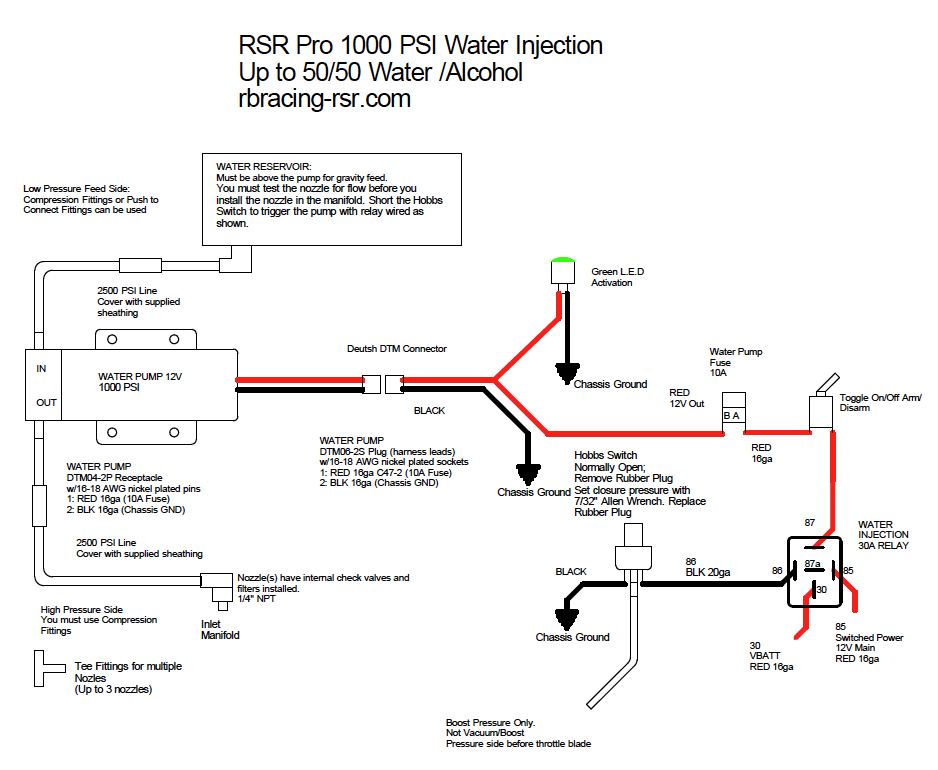
RB Racing: Art and Science 1998
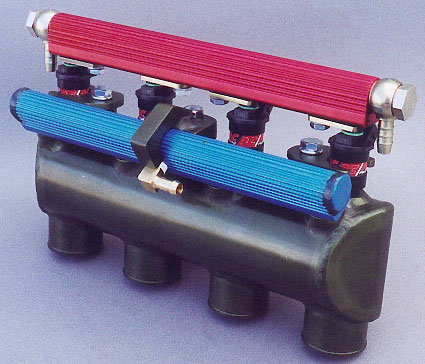
The
blue rail of this BMW K1200RS/GT/LT Turbo Plenum is a port
water
injection system with four nozzles. Water Injection is the
best way to
make power when you are dealing with forced induction systems.
In this
case we are running a turbo on a 11.5:1 high compression bike
and
doubling the horsepower with reliability. There is really
nothing new
about this...We've been doing it for nearly 30 years but
people were
doing it way, way, before we ever came on the scene.
The
red rail is the secondary fuel injectors. You end up with
eight fuel
injectors and four water injection nozzles on a 1200cc
motorcycle. More
holes than Swiss cheese. Hard anodized inlet plenum. Later on,
when we
ran a series of tests, we decided that the port nozzle design
wasn't a
good idea as there was a slight variation in flow
rates...little
consistency.
12
OíClock
High: Six Decades Earlier 
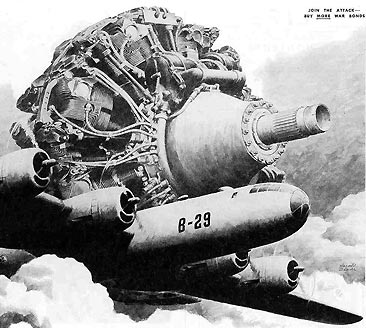
Sir
Harry Ricardo and the High Speed Aero Engine. Incredibly
complex,
turbo-supercharged, radial and V-12 engines that had to take
off with a
full bomb load in conditions that were never ideal. You might
think you
put the pedal to the metal but, for the WWII fighter and
bomber crews,
death was always part of equation...It wasnít a game and if
you
couldnít squeeze out the last bit of horsepower you were dead.
It was
in this environment that water alcohol injection technology
was
refined. Wright Cyclone engine pictured above.
Nothing
has changed except the passage of time. The pioneering
research was
done by people like Sir Harry Ricardo, the researchers at NACA
in
Langley Field and all the aero engine designers of the period
entering
the Second World War. Give credit where itís due and donít
think the
sun only started rising yesterday. Rolls Royce Merlin engine
pictured
above.
For an interesting read you can download a PDF from NACA dated 15
August 1942.
It still applies today. A second NACA
PDF also validates the use of water injection.
Papaís Got a Brand New Bag
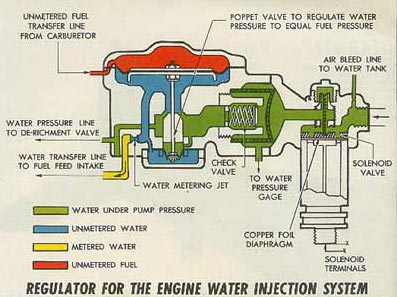
Colorful
3D ribbon graphs, literature full of mumbo jumbo, and
electronic
controls full of potentiometers and blinking lights some 60
years later
is nothing but a new box to hide a heritage born in the skies
over
Europe. People want you to believe that they invented
water...well,
people spend billions of dollars to buy brand name designer
water in
trendy plastic bottles that end up in the ocean and land
fills, so
anything is possible in todayís gadget-filled world. Itís a
brave new
world but to paraphrase a popular political phrase..."Itís the
water
Stupid!". If you want your high output turbo or supercharged
motor to
avoid engine destroying pre-ignition and detonation you are
going to
have to employ water injection and the way it has to be done
was set in
stone a long, long, time ago.
Pictured above is a schematic of a WWII aero
engine
water/methanol regulator...designed over 60 years ago!
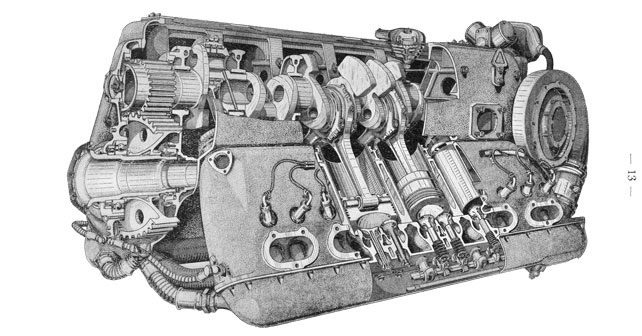
Water and methanol Ė this is the composition
that BMW
concocted in the 1940ís to increase the performance of its 801
aircraft
engine Ė a 14-cylinder that produced 2,000hp. Daimler-Benz did
the same
with the 605 V12 (used by Messerschmitt aircraft) that used
90-octane
petrol and rode the MW50 system, which injected fuel and a
mixture
composed of 50% water and 50% methanol into the cylinders.
That
solution, in addition to ensuring a high antiknock, helped to
avoid the
risk of ice formation at high altitude. A similar system was
adopted
for the R-2800 18-cylinder of the American Company Pratt &
Whitney.
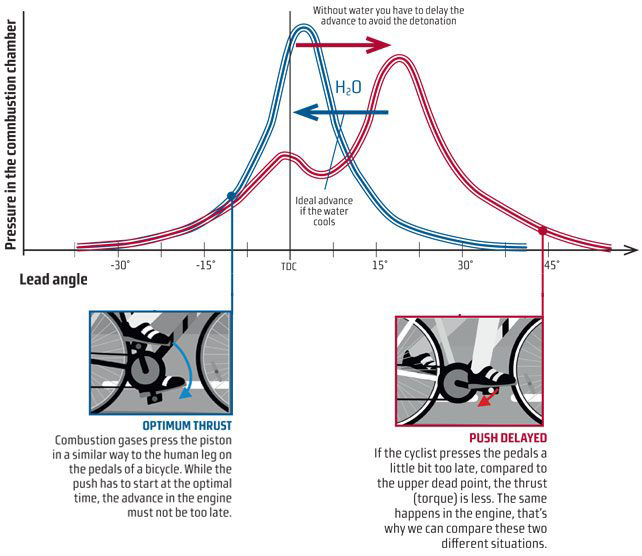
The torque output of a
motor is the result of the thrust exerted on the piston crown,
which
depends on the pressure reached during the combustion phase in
the
cylinders. The cooling produced by the water injected into the
combustion chambers runs the risk of detonation (which would
damage the
piston and the head) allowing engineers to avoid delaying the
advance
angle of the air-fuel mixture with respect to the optimal
value (which
is the time where the first spark happens) Ė with the
advantage of
obtaining a higher combustion pressure. In other words,
achieving a
higher driving torque...with higher boost.
Monster Marine Diesels
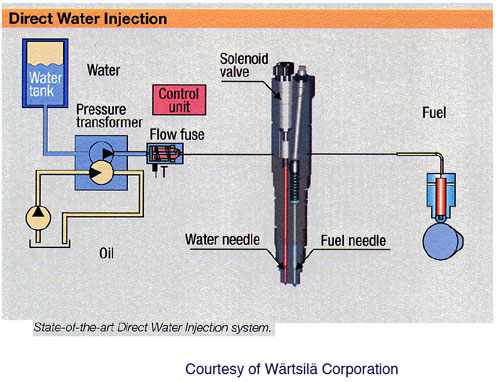
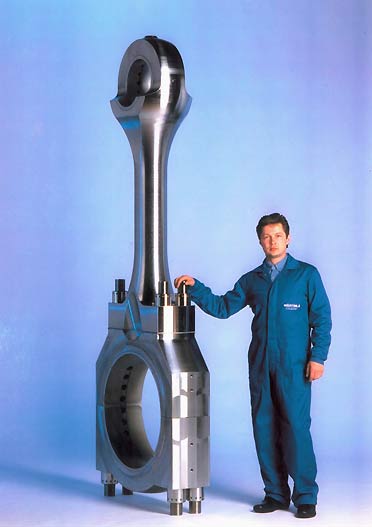
Engines
bigger than your house and they use water injection to reduce
emissions! Diesel engines obviously can derive some benefit
from
cooling the combustion process. This is really big industrial
stuff so
don't think about adapting anything. The company is Wartsila. If you're a
diesel
junkie these things are the pyramids.
Sex Boost Rock
&
Roll...The Formula 1 Era 
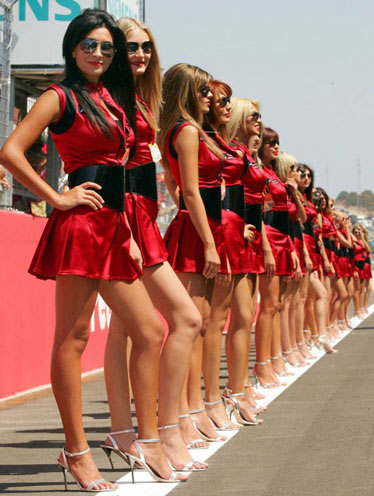
It's
1987 and in your dreams you have your FOCA pass and a
long-legged, high
cheekboned bird of paradise has her tongue in your ear and her
hand in
your Nomex on the biggest yacht in Monaco's harbor. The shrimp
cocktails and the fine wines flow and you've just qualified on
the
front row with your 800 hp turbocharged F1 missile. All abs
and no
flab, not a love handle or a stretch mark in sight, and your
eyes focus
like a Peregrine Falcon in a 200 mph dive. Wake up fool!
You're wearing
glasses, baggy shirts are covering your love handles and
you're seeking
status and approval from other idiots and you sure aren't in
Monaco.
Time
for us to reflect on the big boys, what was, learn a few
things, and
then slink back to our pitiful existence. Monday to Friday
trying to
pay the bills and seeking meaning through our toys.
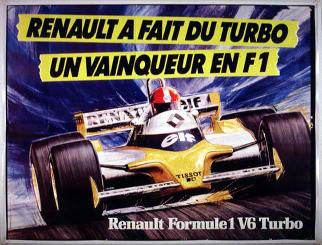
Renault
started it all in 1977. They always start it all. First with
turbos,
first with pneumatic valves, first to use water injection,
first with a
lot of things. Heavy thinkers, great engineers, Ecole
Polytechnique.
Think R5 Turbo. In 1983 the F1 Renault showed up with a 12
liter water
tank, an electric pump and pressure regulator and about 600 hp
from 90
cubic inches. By 1986 the power had been increased to 870hp
but the
water injection was gone as the fuels had improved.
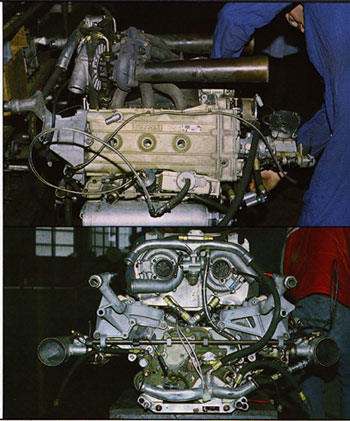
In
1983 Ferrari also claimed to be the first to use water
injection. With
the cooperation of their fuel supplier Agip they managed to
suspend
water in the fuel in microscopic emulsified drops in a ratio
of 90%
gasoline and 10% water. They won the constructors
championship. Like
Renault they dropped water injection when heavier fuel
elements
(toluene) came into use.
Porsche and,
later on, Honda showed up and cleaned house to the point where
turbos
were banned. Honda relied on a mixture of 84% toluene and 16%
heptane
and ran up to 58 psi of boost to achieve up to 1000 hp. Honda
did not
use water injection.
Donít Drink the Purple Cool-Aid
Turbo
gurus, blindly following false prophets, preach the doctrine
of "You
Canít Run Them Too Rich" and demand that you slay the infidel
detonation by richening things ad infinitum. They should have
read Sir
Harryís Book, The
High
Speed Internal Combustion Engine,
but as they say, those who do not know history are destined to
repeat
the same mistakes. Sir Harry Ricardo proved once and for all
that you
can richen things up to a point but, beyond this, detonation
is going
to rear itís head no matter how much fuel you throw at it and,
in fact,
the extra fuel may increase the tendency to detonate! Going
rich beyond
the well-defined 12.5:1 boost maximum power air fuel ratio is
going to
cost you power.
Studies in the early
part of the Second World War proved conclusively that as you
add water
you can lean out your overly rich mixtures as you raise your
boost
pressures. As Sir Harry Ricardo stated..."By the introduction
of
water...the fuel/air ratio could be reduced once again; in
fact, with
water injection, no appreciable advantage was found from the
use of an
over-rich fuel/air mixture". So much
for those
whose perspective begins with their birth date.
I Donít Want
To
Learn...Just Give Me The Answers! 

1. Maximum Torque occurs at a 13.2:1 Air Fuel
Ratio.
2. Transitional Fueling and Maximum Boost Air Fuel Ratios are
about
12.5:1.
3. Water Injection is most efficient with a 50/50 water
alcohol (or
methanol) mixture.
4.
Methanol, as an additive, is not a practical choice as it is
prone to
pre-ignition in higher than 50/50 percentages, is not safe to
handle,
and is not readily available. It's a good choice, but not
necessarily
the most practical one when you need some in a hurry. Methanol
is
usually found where racing fuels are sold.
5. Denatured (ethanol)
alcohol, typically 95% pure, is available in paint, hardware,
and Home
Depot type stores in gallon containers for about $10.00.
Expensive but
available everywhere. Isopropyl alcohol can be used but it is
often 30%
or more water by content.
6. Water Injection allows ignition timing
to be more aggressive or closer to stock. In other words boost
does not
automatically mean retard your timing.
7. Excessive amounts of ignition retard will cause a loss of
power and
overheating.
8. Water to Fuel ratios should be based on weight and not
volume.
9 . Water weighs 8.33 lb per gallon.
10. Alcohol weighs 6.63 lb per gallon.
11. Air weighs .080645 lb per cubic foot. It takes about 150
cubic feet
of air per 100 horsepower. It takes about 12 lb of air per 100
horsepower.
12. Water or Water / Alcohol to Fuel Ratios are between 12.5%
to 25%.
This means Air to Fluid Ratios are between 11.1:1 and 10.0:1
with water
injection.
13. Maximum water delivery should be in higher load low to mid
rpm
ranges tapering somewhat at peak rpms where load is less.
14. Atomization of the water mixture is directly related to it
effectiveness. Finer droplets cool the inlet charge better and
with
less mass they navigate the inlet plenum easier for more equal
water
distribution.
15. Donít flow water through an intercooler.
16. Atomized water, just like fuel, does not like to make
turns thus
making accurate distribution something to think about. This is
why port
fuel injection is the norm. Water is a fluid just like your
fuel. Using
high pressures up to 1000psi for the
best
atomization and even distribution.
Using individual port nozzles is a bit complicated for a large
# of
cylinders and makes control difficult as nozzles vary in their
output.
17. The introduction of water will allow higher boost
pressures to be
run without detonation. Higher pressures will increase torque.
Itís
always about torque.
18. Racing high octane gasoline should be used for all forms
of
competition and for higher than normal boost levels. Water
injection as
well as charge cooling should be used with racing gas. 91/92
Octane
pump gas simply will not cut it. Water spray cooling of the
intercooler
is a good idea.
19. Fuel Injectors operate in the 1 Millisecond range (.001
second) and
are not capable of long term usage for H20 as they will
corrode or rust
shut in a very short period of time. Unless a solenoid can
open as fast
as a fuel injector it should not be used to "pulse" water
injection
events as flow is not directly related to "duty cycle".
20. Varying voltage to water injection pumps or using similar
schemes
is a recipe for disaster. You have to eliminate the variables,
not
increase them.
21. Fuel Injection pumps cannot be used for water injection.
Water is
conductive. Gasoline is not. Water will corrode an efi pump
shut in a
very short period of time.
22. Water injection has a cooling effect on the engine head,
valves,
and cylinder. Exhaust temperatures (EGT) are largely
unaffected at
recommended water / fuel ratios.
23. The cooling of potential hot spots in the combustion
chamber
defeats pre-ignition, the most destructive form of
uncontrolled or
unplanned combustion.
24. Higher static compression ratios will require a higher
percentage
of water or water / alcohol.
25. No, water does not burn. We are not combusting the
hydrogen in the
H2O.
26. At around 13.2:1 or fuel air ratios of .75, EGTís will
peak.
27.
People will try to selectively edit their way to get you to
use water
injection by stating "One can basically double the power
output of an
engine using water/methanol" and "It was used effectively in
Formula 1
before being banned for adding too much power". This is pure
bunk.
Water or water/alcohol/methanol does not make
power...superchargers and
turbochargers make power. The cooling effect of the water
injection
only allows you to run higher boost pressures and leaner
mixtures
without engine damage. The increased density or higher
pressure ratio
is what makes the power, not the water. The last time we
checked water
wasn't a very good fuel. Water Injection definitely does not
give "a
5-15% increase in fuel economy" as some marketers clain.
28.
Ferrari suspended water in their fuel during their 1980ís
Formula1
period. We donít recommend that you try this...although
Acetone will
mix with water.
Running Water Injection since
1980 
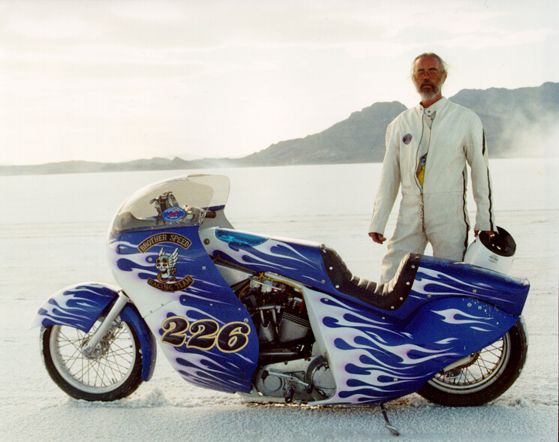
Harley-Davidson,
Suzuki, BMW, Hondas, Kawasakis, Triumphs etc....all our race
bikes have
run water injection since the early 1980's. The thermal loads,
even
with intercooling and racing gasoline are too high and without
water
injection you simply can't run mile after mile on the long
course at
Bonneville without some additional form of charge cooling.
Running 22
psi of boost between the two mile and four mile markers day
after day
and no engine failures. Mike Geokan's famous
#226 Blue Bike and his new Bonneville
Bullet
use RSR Water Injection.
Nearly 30 years of water injection and turbos.
We
have been in the high performance business since the late 1970's.
Water Injection History at RB Racing
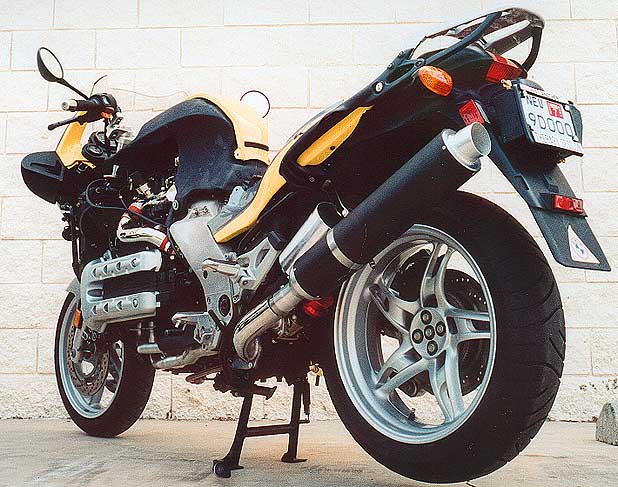
Early Systems:
Way back around 1980 and a few times later on we did not
even use
pumps. We simply used boost pressure to push water into the
engine
through a small nozzle. What we would do was hard anodize an
aluminum
water container designed to be bolted to a specific location
or in some
cases to be collocated with the license plate at the rear of
the bike
(see above photo). We machined up o-ring sealed screw-on
caps. The hard
anodization was to prevent corrosion from water, methanol,
or alcohol
mixtures. We would employ a viton sealed check valve with a
specific
cracking pressure, typically around 5 psi, and flow the
water through a
small jet, usually .6mm, into the turbo inlet. You could not
flow the
water after the turbo as there would be no pressure
differential.
Flowing water through the turbo could cause problems with
throttle
shafts, mass flow sensors (LE Jetronic) and had a tendency
to corrode
any pot metal structures. We made hundreds of such systems
on
carbureted turbo kits for many different kinds of bikes.
Early K1200 turbo with water
reservoir
under license plate.
Next Step In Our Efforts:
In the late 1980's and through the mid 90's we went to
intercooled
systems both with blow-through carburetors and from 1989 on
with our RSR Fuel Injection
systems. You cannot flow water though an intercooler and
based on our
earlier efforts we wanted to inject water after the turbo
and not into
the turbo. We sort of went a radical direction that meant
that things
were no longer practical but, what the hell, you have to win
races and
set records. If you are running for six wide open miles at
Bonneville
you must know exactly how much water is going into your
engine. We did,
and we never lost an engine.
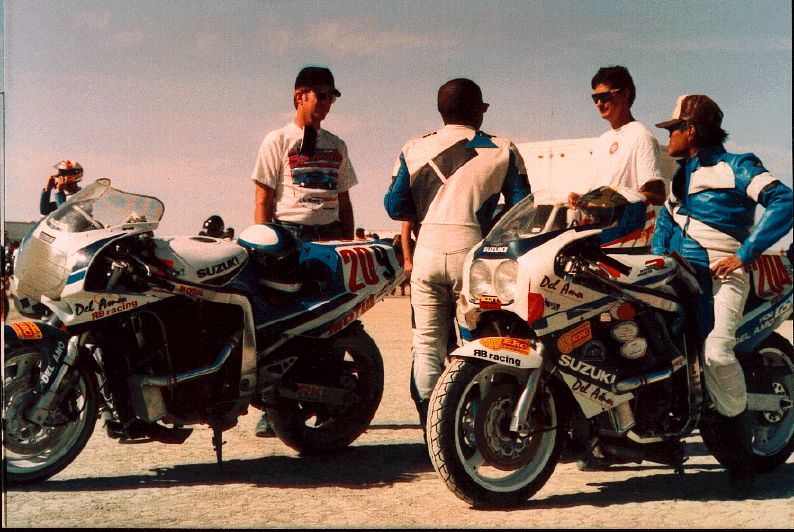
What
we did was use hard-anodized water reservoirs, fuel
injection pumps,
fuel injection pressure regulators and actual fuel injectors
to deliver
water, all under RSR EFi
control. The
problem with this is water will kill fuel injectors, rusting
them shut,
even if left overnight. Water is conductive, gasoline is
not. Gasoline
has lubricity, water does not. Fuel injection pumps will
rust shut and
die if water is run over an extended period. We would race
at
Bonneville during the day. At the end of each day we would
drain the
tank, pull the water injectors, and flush the system with
WD40 and
gasoline. The next day we would put in new water, get the
water
inspected, and have the container sealed by tech officials
so we could
stay in the gasoline class. It was a big hassle. Safety wire
pokes
holes in your fingers. Blood is slippery.
People
used to ask us to duplicate these systems for them and we
refused
because it was too costly, too labor intensive, and when we
let other
people run the bikes they did zero maintenance and the
systems rusted
shut and failed. Usually they would detonate and blow the
porcelain off
of a spark plug when the water injectors would not open. We
got tired
of baby-sitting our systems for non-appreciative glory
seekers.
Two
Suzuki GSXR RB Racing Turbos. RSR Fuel Injected, intercooled
and water
injected. E-Ticket to El Mirage and Bonneville 200 mph
clubs.
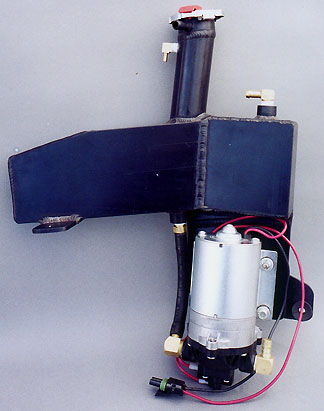
Clunky Period:
To get away from the labor intensive efi pump systems we
tested some
commercial Shurflo and Flojet water pumps. They were
heavy, had large
3/8 NPT and 1/2 NPT fittings, and non-waterproof spade
electrical
connectors. They were, however, designed to pump water,
could be
operated "dry" without damage, and did not rust shut. Some
alcohol
or methanol variations would eat the plastic components.
Pictured
above is a Shurflo pump we tested on a BMW K1200RS. It
wasn't really
elegant but it did work and we had to invent a regulator
to keep the
flow constant as it did not have an internal bypass
circuit. Its large
size makes it serious
packaging problem on a motorcycle. After some testing we
got rid of the
clunky pump.
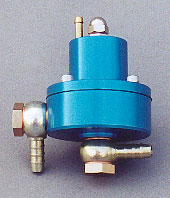
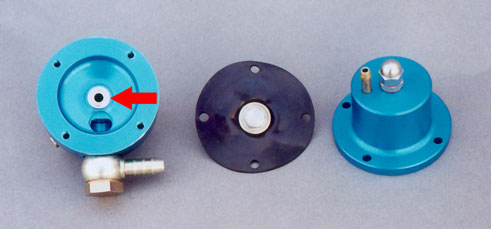
These
are the billet regulators we machined up with Titanium
seats and double
nitrile diaphragms for testing. The Shurflo RV pump would
bypass water
from the
regulator back to the anodized reservoir and the boost
pressure was
referenced to the upper part of the diaphragm to keep the
water
pressure constant. More complication. They were pretty
things. The lure
of billet parts, the siren call. Don't ask us for one. We
don't make
them anymore.
Hose Tech
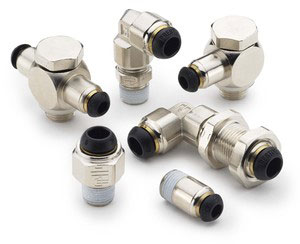
Since
we have about 35 years experience with carburetors, fuel
injection and
water injection, we have used about every type of hose and
fitting you
can think of. In fact, way back in 1980, we used some of the
first
"push to connect" fittings (Alkon)
on air shifters that we used to make. Virtually all water
injection
sellers use these type of O-ring fittings as they are easy
to work
with. Measure, cut, push, done. The problem we have with
these is they
aren't rated for our 1000 psi pumps.
We use high pressure compression fittings and
2500 psi hose. We cover the hose with 1200
Deg F fiberglass sleeving for flame and abraision
protection.
Water Reservoirs and
Calculations
You're
on you own here. There are all sorts of windshield washer
bottles,
radiator overflow tanks and fabricated assemblies that you
can figure
out on your own. Poke around and you can find about anything
in an
autoparts store. Too complicated for us. We tried dealing
with a few
companies like Flambeau but
it was a complete waste of time as we won't compromise and
we
positively hate clunky generic crap.You mess with
it...engineer your own.
For your calculation purposes: 3785cc/gallon.
If you
use the 03-1001 330 hp System (180cc/min) you have about 20
minutes of
operation per gallon i.e. 3785/180=21.02 minutes...or a
quart every 5
minutes of operation. At 330 hp the water to fuel ratio is
12%...more
at lower boost activation points. On the safe side call it
15 minutes.
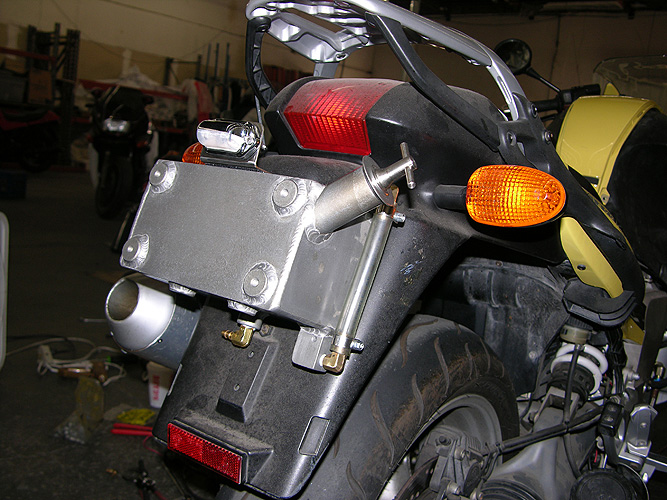
This is a reservoir we fabricated for our BMW
and
Harley Davidson Turbocharger
systems. It bolted to the license plate mounting points with
blind holes
hold the license plate. A clear hose provided a liquid level
site
gauge. Hardcoat Anodization is used to protect
against water/alcohol corrosion. Motorcycles do not have
"engine
compartments" and space is at a premium. Expensive and time
consuming to make.
We got religion after making a number of these
and switched to molded plastic tanks.
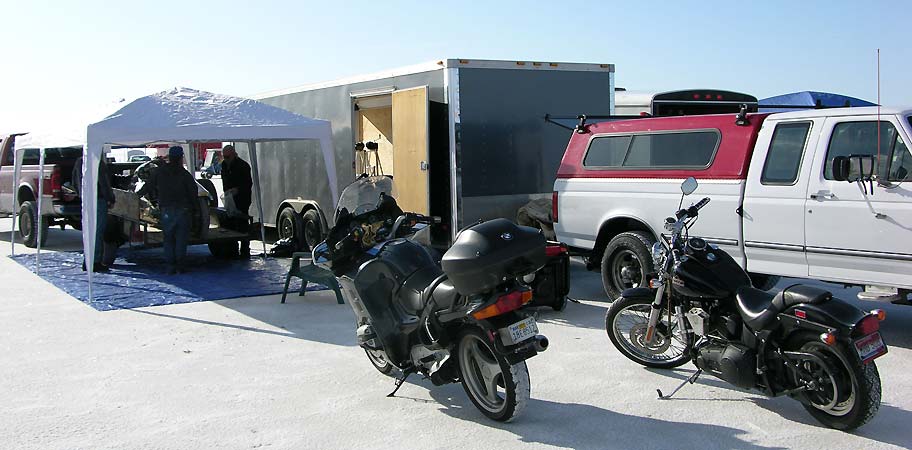
Here,
mounted on a BMW R1100RT Turbo, the water injection was used
on a 2000
mile test riding to the Bonneville Salt Flats where we were
racing the
Bonneville Bullett. Running pump gas the bike did
not detonate up to 15 psi with a 10.7:1 compression ratio.
Above this
race gas is called for. We ran two small nozzles to cover the
240 hp.
Don't try to pass semis in the midle of nowhere at 150
mph...we did and
don't recommend it.
RSR
Water Injection
Pump Tech 
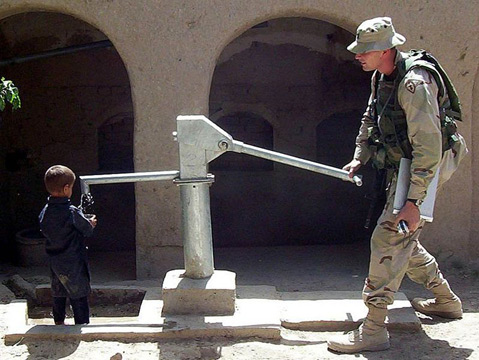
Basic Calculations:
We have to plan our pump design, quite logically, on the
required
delivery of water or water-alcohol mixtures to our
target. Take a
simple hypothetical situation of 300 horsepower which,
at a B.S.F.C. of
.5 lb per horsepower per hour (150 lbs of fuel)...which
equates to
about 22.62 gallons of gasoline per hour (150lbs / 6.63
lbs per gallon
= 22.62). If we are trying for 15% of the mass using
100% water the 15%
is .15 x 150 = 22.5 lbs of water per hour.
22.5
lbs water / 8.33 lb per gallon = 2.7 gallons per hour
water
consumption. To calculate cc's we multiply 2.7 x 3785cc
per gallon =
10,219 cc's. To calculate the cc's/minute of water
needed we to divide
by 60 which gives us 170cc's per minute.
We used the same planning
when we were
using actual fuel injectors to deliver water at
Bonneville.
Design Quandary:
This
brings us to an interesting conclusion concerning the
water pumps
people use for water injection systems. Companies like Snow
Performance and others
use Shurflo
diaphragm water pumps that were designed for
agricultural, recreational
vehicle (RV), marine, or industrial fluid transfer
situations. These
pumps are rated in the range of 1.4 to 3 gallons per minute
which is
way, way, beyond the 2.7 gallons per
hour
of water we need for the hypothetical 15% contribution
to 300hp. If you
remember we only need 170cc per minute of water for 300
horsepower. The
Shurflo pumps push out around 8000
to 19,000 cc's per minute.
Actually there is no penalty for wretched excess but do
you really need
a 5 or 6 pound bilge pump to deliver 170cc's per minute?
It's
pretty easy to see that these diaphragm pumps are not
really the best
pump design for water injection. They are big, clunky,
heavy and are
designed with 3/8 NPT and 1/2 NPT fittings. Just the
thing for an RV
sink but hardly the best pump for a water injection
system. They are
cheap and they do pump water reliably.
Another thing they do not
tell you is
that the rated presures, say 150 psi, are not
consistent. Don't
even think about pulse width modulating slow solenoids
to control water
flow. At 150 psi with fluctuating pressures the
atomization is
incosistent.
Considerations of Pump Design
1. Diaphragm
Pump Motor Design: The
solution
to this problem is defined by the problem: Water is
corrosive,
has poor lubricity, and must be isolated from the pump
motor. The best
way to do this, with some caveats, is to separate the
pumping mechanism
and the pump motor. Diaphragms, pistons, gears, swash
plates, magnetic
drives are all on the table.
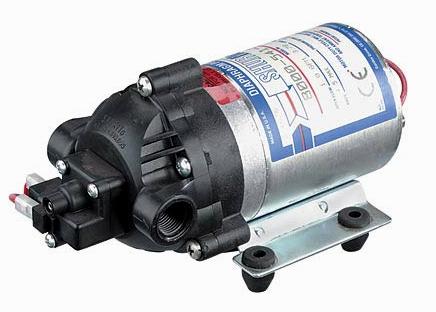
Shurflo
diaphragm pumps (usually model 8000, 8030 or similar)
are used by firms
and private individuals like Alcohol
Injection
Sytems, AEM,
Snow
Performance, Devils Own,
and probably about 50 others . These pumps are all
about 5 to 7 pounds
in weight and about 8.5" to 10" in length. These are
not magnetic drive
units. A number of DIY water injections use these type
of pumps. Even
Aquamist offers a Shurflo unit for about $900.00. They
all claim or aim
for the highest pressure rating...None are anywhere
near commercial
misting pressure ratings.
These guys all say they are better than
the other guy
and they seem to like to try to sue each other out of
business. It's
just a packaging buisness. We have an electronics
acquaintence who was
asked
to design a control module for one of these
firms...The target was a
cost not more than $25.00 to$30.00, they would not pay
for the design
time, and
it would have a retail of $200.00. Like we said...it's
a packaging
buisness.
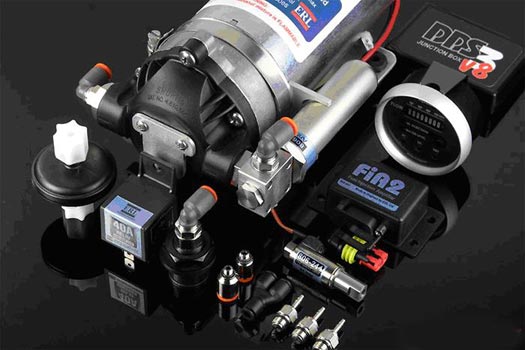
People
make businesses out of packaging these parts. It's
nothing new and just
an easy way to put some parts in a box without having
to engineer out a
custom product like the older magnetic drive solenoid
Aquamist
solution. Greed is good. If you
are running a ton of boost in a Diesel they are a good
choice as some
models will put out 150 to 250 psi as diesels can run
40 psi or more
manifiold pressure.. No one uses regulators like
we
did at Bonneville. Some use
internal bypass
...These are just on/off and deadhead at the nozzles
and solenoids.
They are also very loud in operation. Clack Clack
Clack.
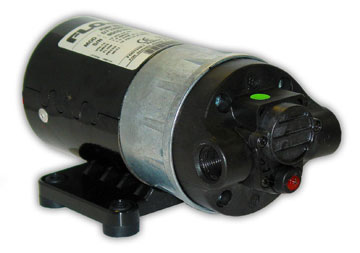
Flojet
is the
other main water pump manufacturer. They are similar to
the Shurflo
units. They are still big and clunky.
2. Magnetic
Piston Pump Design: Diaphragm
pumps are large, have huge NPT ports, and can be a bit
problematic, and
are next to impossible to fit into vehicles like
motorcycles. It's a
design
fact that you need a certain amperage, torque, and
pump capacity to
fill a sink or empty a bilge.
Magnetic
drive designs isolate the pump motor from the water
medium and are
exponentially more reliable than other designs. There
is no mechanical
coupling of the pump and pump motor. Companies like Aquamist
used to make magnetic drive pumps. The problem with
most magnetic drive
pumps,
which typically use impellers, is that they are very
low pressure
units, for the most part less than 3 psi. That
certainly won't work for
forced induction applications.
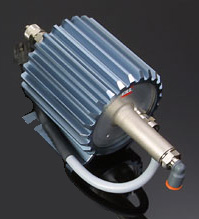
Aquamist
pumps early on, on the other hand, were quite elegant
and were
magnetically driven. Aquamist had been the gold
standard for
purpose-built water injection systems for a long time.
They used a
small piston actuated by a solenoid coil and were high
pressure, low
volume designs due to the limited bore and stroke of
the reciprocating
piston, which was surprisingly small. They were
regulated by pulsing
the
solenoid. If you wanted to flow more than a certain
amount of water,
about 300 ccs, you were out of luck. The volume,
beyond this point, was
simply not there, the pump was at its limit. Say you
wanted to run four
separate nozzles in your manifold and two nozzles to
spray your
intercooler. You run out of pump capacity. D'Oh! They
wanted you to run
two of the pumps beyond this point. The fins do look
neat however. They
also had nifty ribbon charts and trim pot electronics.
Aquamist finally gave in
and went to
clunky
conventional Aquatech pumps...Less than $50.00 for a
big pump
is too much a temptation.
3. Gear Pumps:
We
researched out small 12V Gear pumps but there were
limitations in pump
flow and pressure.
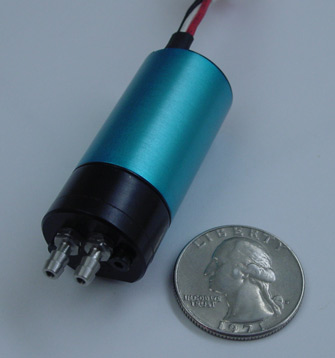
This
cute little unit was rated at 500cc/minute with a
pressure of 80 psi.
The problem as that it was a custom unit and the cost
was $650.00 each.
80 psi wasn't enough pressure.
There is always a catch. Physical limits get in the
way when you go
small,
and custom design always costs money. It required
custom PEEK gear
material to pump water. 80 psi was too low for proper
atomization, so
this was a dead end.
Shurflo Pumps....Everyone's Solution
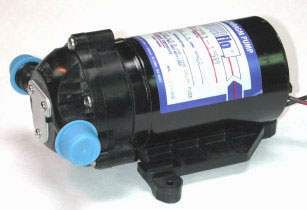
We
almost signed a contract for a large number of
these units that
everyone in the water injection packaging
business uses. You buy enough
of them and they are less than $50.00 apiece.
The economics seem
compelling, but we came to our senses,
luckily, and decided otherwise.
We used them before and we never were happy
about the situation. They
are clunky, noisy, and heavy. Three strikes
and you're out. The Chinese even make copies
of
these if you are feeling adventurous or want
to go into business
selling water injection systems.
Research...Bermuda Triangle and the
Holy Grail
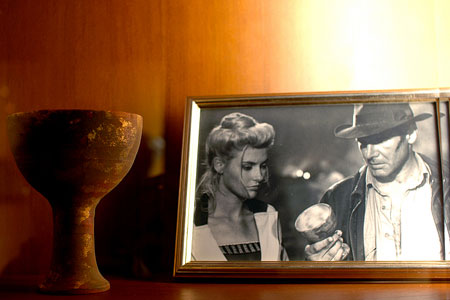
Step 1: Round Up The Usual
Suspects:
Commercial diaphragm pumps like Shuflo and Flojet are
pressure limited
to 60 to 70 psi (controlled by internal bypass) or 150
+ psi
uncontrolled. The $900.00 Aquamist/Shurflo unit uses a
125 psi internal
bypass.These pumps are big and, when rated in gallons
per minute, are
way out of bounds except for use in industrial
settings as bilge pumps
or crop sprayers. Specialized Aquamist magnetic pumps
were sexy but
volume impaired (300cc) by their small reciprocating
piston. Aquamist
wanted you to use two of their pumps if you need
additional flow. They
even gave up on their own pumps.

Step 2: Physics 101:
We looked at all the possibilities to make the
perfect pump i.e. swash
plate, diaphragm, impeller, peristaltic, gear driven
etc. and they all
came up short. Either they were pressure limited,
volume limited, or
impossible to package in anything but a large
multi-pound package.
Fluid is not compressible so you need a lot of force
to generate high
pressures. You need large DC motors to actuate
diaphragms, gears or
pistons and the higher the pressure the more
amperage is required. No
free lunch.
Step 3: Just Do It:The
solution
was to engineer a more powerful pump that would be
small
enough enough fit in the palm of your hand, and one
that would run four
to six times more pressure than the other pumps.
Rubber isolation
mounts would
be needed to dampen vibration. The solution had to
be a positive
displacement piston pump without diaphragms. It had
to be elegant,
durable and as they say
"bulletproof". Bonneville proof.
The below was the solution we came up
with...Maybe
not the
best...but good enough for our racing activities.
RSR Pro 1000 PSI
Pump...David Slays Goliath 
RSR Pro 1000 PSI Pump
Advantages
Correct Flow:The RSR
Pump has the
power to flow 640ccm. At 170 cc's per minute per
300 hp you can flow enough water for most any
application. The smallest
"A" nozzle flows 150ccm @ 650 psi for about 265 hp
worth of water
protection. Two small "A" nozzles flow 225ccm @ 360
psi or about 400 hp
worth of water protection.
One large "B" nozzle flows 285ccm @ 250 psi or about
500 hp worth of
water
protection.
High Pressure:
The RSR pump is rated at 650psi with the smallest
"A" nozzle
flowing 150cc's/minute. RSR Nozzles deliver a fine
mist, like
a fog, that will pull the maximum heat out of your
inlet charge. Even
smaller nozzles will push the pump to 1000 psi, but
the flow will cover
even lower horsepower applications.
Quiet: Diaphragm
bilge pumps are
noisy. The RSR Pump is very quiet, with only a faint
hum.
Small and Elegant:
It is an elegant solution that is compatible with
water, alcohol,
methanol and any fuel you can think of. Small enough
for simple
packaging and covering over 530 hp @ 250psi and
300ccm. Keep in mind we
only need 170ccs for 300 hp.
Low Amperage Draw:
The RSR "Pro 1000
PSI" only draws 3 amps of power @ 1000 psi. Supplied
with
Deutsch
DTM sealed connectors and MIL-22759/16 wire.
Durable and Long Life:
No diaphragms
to fail. 1500 hrs rated for pump.
No Nozzle Leakage: No
dripping of nozzles for two reasons: (1) The pump
itself acts and a
check valve preventing any flow if the pump is not
running; (2) Our
nozzles have built-in check valves and filters which
prevent any
siphoning in vacuum or on shut down.
Mixtures...50.50 
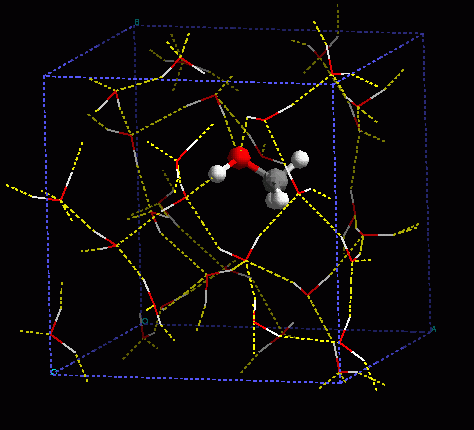
The
new pumps are alcohol and methanol compatible . We
recommend denatured
(ethanol) alcohol available in hardware, paint and
Home Depot type
stores as it is not watered down like Isopropyl
alcohol and is easier
to obtain than methanol. A 50/50 mix is optimum.
Nothing is wrong with
methanol per se, aside from it's corrosive nature,
but it's not always
easy to find. You can always dump in some cheap
isopropyl alcohol, but
it's mostly water anyway. If you are determined to
run methanol you'll
find it where racing gasoline is sold and it can be
ordered over the
internet. You will pay shipping and a "Hazmat"
surcharge though.
People ask us about running pure
methanol or even
mixtures like 40% water and 60% methanol. We advise
against this.
Volatility is the key. Any volatile mixture will
detonate at some
point...But a more important consideration is high
pressure venting
around a hot engine. At Bonneville we saw a severe
fire situation in a
streamliner that was using a supposedly better
engine coolant that,
when spewed out into the engine compartment, it
ignited and torched the
driver's hands, helmet and the liner's engine
compartment. Keep your
mixtures @ 50/50.
Methanol molecule CH3OH with it's
water brethren H2O.
They do have an affinity for one another.
Rocket Fuel
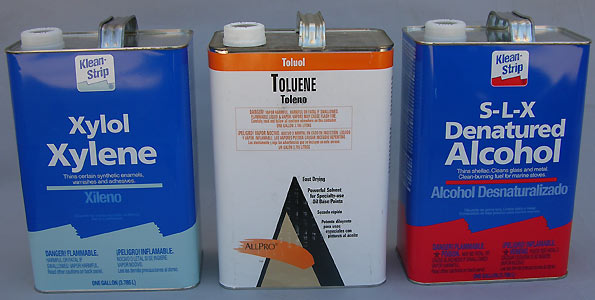
When
Honda was spending 500 millions dollars a year
on their V6 Formula 1
Turbo motors they ran a mixture containing 84%
Toluene (114 Octane). It
has excellent anti-detonation properties and
increases your octane
rating. If you are running 92 octane pump
gasoline and you add this
stuff, your octane rating will be changed by the
formula:
[(Quarts Gas x 92) + (Quarts
Toluene x 114)] /
(Quarts Gasoline + Quarts Toluene).
For
example, if you add one quart Toluene to four
gallons of gasoline, your
Octane will increase onr point from 92 to 93.
Add two quarts to four
gallons and you get an Octane rating of 100. For
you high boost junkies
this is something to ponder. You can buy the
product in hardware
stores. Xylene has a higher flashpoint (less
volatile) and has and
octane rating of 117.
Denatured alcohol or methanol can
be added in a 50/50
mix in our water injection systems.
Methanol Mix and Economics
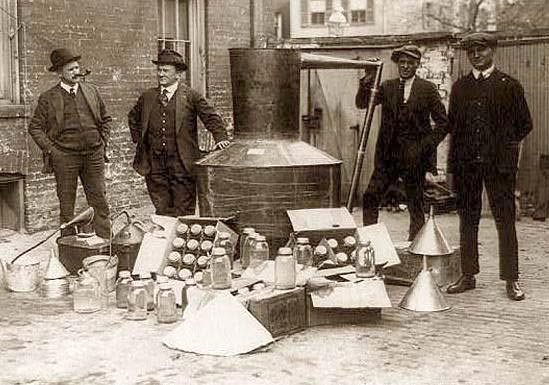
Figure
out the economics. Buy a gallon of denatured
alcohol at Home Depot for
$15.00. The weight by volume is: Water 8.33 lb/gal
and alcohol 6.63
lb/gal. Water weighs 1.25 times that of alcohol.
If we mix by molecular
weight and do the math it will be 44/56 water to
alcohol if we measure
volume. This is too complicated, so let's just do
two quarts of alcohol
or methanol and two quarts of water per gallon.
The water is free (more
or less) so each gallon of 50/50 water/denatured
alcohol will cost you
$7.50 ($15.00/2). If you buy a methanol mix mail
order the brew will
cost you about $13.00 per gallon with shipping.
Now
if you have a race gas outlet near you 5 gallons
of Methanol will cost
you around $34.00. This brings your cost down to
about $3.40 per gallon
of 50/50 mix of water/methanol. If you have to pay
shipping for the 5
gallons your cost is going to be around $5.40 per
gallon for the 50/50
water methanol mix. Oops! there is a $20.00 UPS
Hazmat fee so that
brings the cost to $9.40 per gallon if you ship
your methanol in.
In
short, it's sort of silly to ship water around,
even if it is mixed
with methanol or denatured alcohol. Hey, you pay
more money for your
bottled designer water so go ahead and pop the
$13.00 per gallon for
the premix and shoot up your boost juice. If you
can just drive over
and buy some methanol of denatured alcohol you'll
be way ahead of the
cost curve. Some race tracks sell methanol fairly
cheaply.
Hey,
if you mix your own, cheat a little and go 60%
water and 40% methanol.
No one will know and
you can skim the profits. It's the American way.
Mobsters used to do
it...now it's corporations and the government.
Halliburton and no-bid
contracts. Hell, put in some red or blue dye and
give it a catchy name.
Millisecond Tomfoolery
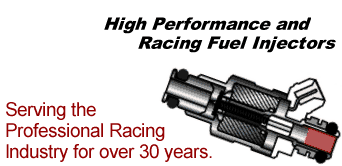
A
technical point about the delivery of the water is that we do
not
attempt to modulate, pulse or otherwise try to modify the flow
of the
water through the nozzles. In the late 1980's and early 1990's
labor
intensive systems, where we
used actual fuel injectors, the response time of the injectors
was
around 1.6 milliseconds (0.0016 seconds) before linear flow
could be
predicted. By using actual fuel injectors we could precisely
pulse the
water flow with controllability down to a fraction of a
millisecond in
this linear region. It
was a very short term solution. It was absolute in its
control, but it
was far from practical.
Trying to pulse
non-efi solenoids is crazy as they have very slow response
times,
typically around 10-15 milliseconds, or about six times slower
than a
fuel injector, making the delivery of water a very "notchy"
proposition. Figure it out yourself. At 6000 rpm there is 10
milliseconds per revolution and each four stroke cycle takes
two
revolutions or 20 milliseconds. If the solenoid takes 10
milliseconds
to open and a good portion of that is non-linear then water
delivery
via duty cycle variation is a bit non-linear and problematic.
No one
tells you this. The knobs and trim pots they give you are very
comforting however.
Another
control strategy is frequency, or voltage modulation of the
pump
itself. This is not a wise move and brings an unpredictability
to the
situation. High end ecus typically employ FPGAs and very high
speed 32
bit processors to control things. Not a good idea to think you
are
modulating things accurately by varying duty cycles of the
pump...way
too crude.
It is better to treat the water flow
as a constant flow (CIS) to pull the maximum heat out of the
inlet
tract without "missing" inlet events. Treat the water
injection like an
analog carburetor.
The
best strategy is to size the nozzles to provide the correct
peak flow
of water at the highest load and then to taper it back to a
figure of
12 to 15% of the liquid mass entering the engine at peak rpm.
This way
you will know what
is happening beforehand and not twiddling some potentiometer
and not
knowing what is happening downstream.
Large Industrial Check Valves in
the
Lines...+/- 20% Problems
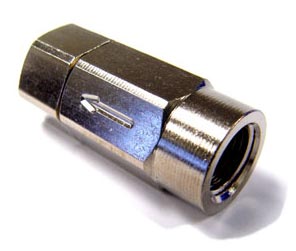
Large Industrial Check Valves, placed in the
lines,
to be effective to prevent vacuum siphoning, need to have
greater than 15 psi (1 Bar) cracking pressure. A 15 to 20 psi
check
valve will knock exactly that much off of your system pressure
which is
hurting the atomization which becomes finer at higher
pressures. If
your pump is only putting out 100 psi this can be a
significant
variable.
One
thing people do not think about is, if you employ multiple
Industrial
Inline Check Valves
and multiple nozzles you are going to be dealing with two
unplanned for
inconsistencies. First, some of the valves are going to leak.
They
always do. Secondly, they never crack at the same pressure and
will
easily "crack" at +/- 20% of the advertised value i.e., in
some
situations, some will open and some won't.
We
don't use them. Too many problems. Our RSR Pumps are, in
effect, check
valves as will not flow when they are not in operation. In
addition we
use precise nozzles with tested cracking pressures. In that we
use 450
to 1000 psi line pressures there is no variation in single
nozzle
applications and little if any variation in dual nozzle
applications
Solenoids to Prevent
Siphoning...No; Control...No
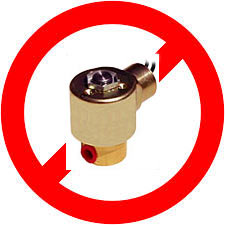
In some low pressure systems a
12VDc bubble-tight, normally closed, solenoid with a filter
can be
placed
between the water pump close to the water injection nozzle(s).
When the
pump is triggered the solenoid opens. This prevents water from
being
sucked from the nozzles in the higher manifold vacuum. Water
dripping
post shut down can cause internal corrosion.
The
solenoid insures there is no possibility of water flowing to
the
nozzles unless boost is present. It also prevents either
vacuum or
boost from causing either water drainage from the lines, or
boost
backflow though the system. The solenoid is normally closed
and
activates under the user defined onset of water injection
triggered by
the pressure activated switch.
Our 450 to 1000 psi pump acts as a check valve
itself
and we use precise check valves in our nozzles so we do not
need
solenoids. Another issue with these is they are really not for
water.
We don't use them. You do not deadhead 1000psi.
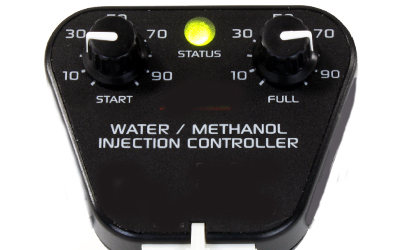
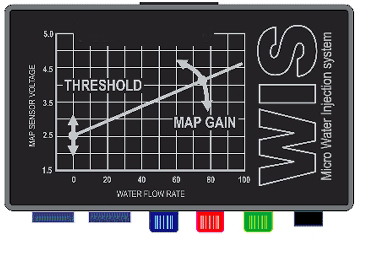
Unlike fuel injectors
which
can control flow, in their linear range, to .000001 seconds
(.001
millisecond), typical solenoids used for water injection
systems really
only work in the 20Hz range and their opening times are in the
10-15
millisecond range, a large portion of which is non-linear. In
short
these are band-aids and are more of a marketing device than an
actual
control system. Using knobs to "control" these solenoids,
which were
not designed for water in the first place, is a bit silly.
Placebos.
More of a marketing device.
Upstream, Downstream, and
Orientation
Nozzle placement is most often decided by the
architecture of the application. They can be installed in a Boost Only area
such as
in the plenum or plenum runners before the throttle body, or
in a Vacuum-Boost
area in the inlet tract behind the throttle body or air
metering
throttle valve (butterfly). Flowing water before the butterfly
is not a
good idea due to corrosion issues.
If
you have a mass sensing systems of some type, you can't inject
water
before the sensing element as this will drive the hot wire or
sensing
element crazy. In this case you will have to place your nozzle
downstream of the butterfly in a vacuum-boost area.
All
RSR pumps are essentially a check valve for the system and
unless
activated no water flow can take place. There is zero
possibility of
siphoning the water from the reservoir in a vacuum situation.
Our
nozzles also have built-in checkvalves and filters.
30 Amp Relays
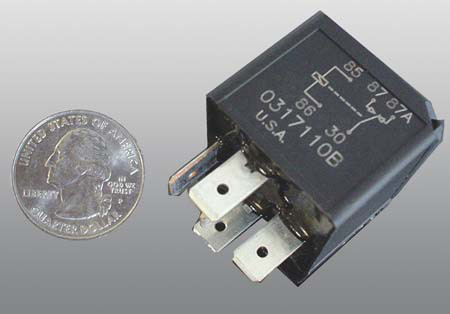
There
is a logic behind how the RSR Water Injection is hooked up and
how it
gets it's power, which requires a relay. You want to be sure
the
water is not activated when the engine is not running and only
activated under pre-defined boost levels.
Hobbs Boost Pressure-Activated Switches
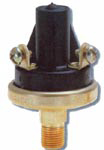
User
adjustable to trigger specific water injection events. There
is usually
just one of these used to turn on the pump and open the
solenoid.These
are usually referenced to plenum or boost pressure and not
below the
throttle where both vacuum and boost is present. Adjustable
from .5 to
150 psi. 1/8 NPT. Water injection is best turned on and off.
Pulse
width modulating agricultural pumps and slow acting
solenoids is a
recipe for inaccurate water delivery. Activate at highest
load at lower
rpms.
Simply set the
pressure switch with a test light, pressure gauge and either
a Mityvac
hand pump or compressed air source. Use a 7/32" Allen wrench
to set
pressure activation point. We use genuine Hobbs switches and
they have
gotten more and more expensive as time has gone by. Simple.
All RSR Water Injection Systems have a manual
disarm
switch (on / off) that can deactivate the system.
ECU Activation

These days we use high end Cosworth
SQ6M ecus
with front end
FPGA's to run the calculations on when to "turn on" the
water...not
some add on box with blinking lights. The SQ6M is programmed
to trigger
a relay to activate the water injection for a variety of
parameters.
This box is about $7,000.00. Figure $3,000.00 for custom
wiring harness
and sensors. We use them on our Bonneville and street
high-end Harley turbos.
With the SQ6M and other engine management
systems you
do not need a Hobbs Switch. Some people want to use
solenoids and PWM
(Pulsewidth Modulation) to control water flow. We just use
the SQ6M to
turn it on with a relay as the pulse modulation with a slow
acting
solenoid is a bit problematic.
Normally Aspirated...Not Our Bag
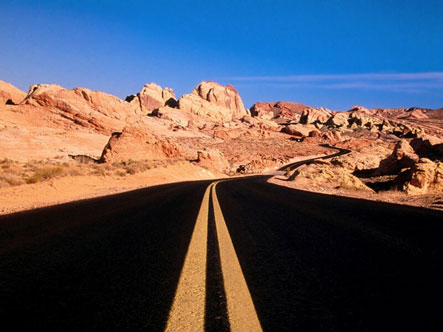
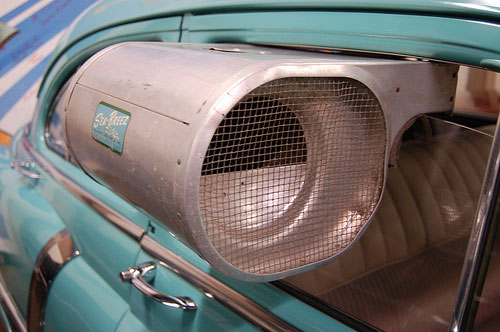
Some
people want to use water injection with non-boosted,
normally aspirated
engines. High desert heat, high compression etc. This is not
an area we
are going to do development in. If you choose to do so you
can source
vacuum operated switches yourself to control the activation.
You are on
your own in this regard. We remember the Spearco Injectronic
units way back when and even got to baby-sit George and Pat
Spears
booth at a SEMA trade show once eons ago. George dropped out
of the
turbo and water injection business, ditched his previous
connections
with Carroll Shelby, and went into the intercooler business
which he
later sold, then retired. The engineering, nozzle, sizes and
strategy
is up to you.
Some vendors promise a 5 to 15% increase in
fuel
economy. They also have a big bridge for sale.
You
can even rig something up to spray you if you so choose.
We're
turbocharger specialists. You get to be the other specialist
whatever
that is.
Digital Turbo Dashboard 

Shown here running at 2.64 Bar (24 psi) in
bright
sunlight. You can read more about the
ORCA Turbo Dash development.
You can also
watch a movie
of the dash in operation on one of our turbocharged Harleys.
3 Bar display
with 30 leds 30"Hg to 30 PSI (3 Bar). First ten l.e.d.s are
green and
represent the 1.0 Bar Pressure range. The second ten l.e.d.s
are orange
and represent the 2.0 Bar Pressure range. The last ten l.e.d.s
are red
and represent the 3.0 Bar Pressure range. A three digit "Bar"
digital
read out (0.00 to 3.00) is directly below the 30 l.e.d.s.
There
are two four digit Type K Thermocouple displays which can be
used to
monitor two egts or any other temperatures like charge cooling
etc.
Celsius and Fahrenheit selectable by pushing blue and red
buttons
simultaneously. Last digit displays "C" or "F" in bright
green.
Two
l.e.d. display lights for water injection: Blue l.e.d. for
water
injection pump activation. Three
button control for the display functions: Blue: high recall;
White:
display dimming function; Red: reset of high recall. Simple,
logical.
Bonneville race quality.
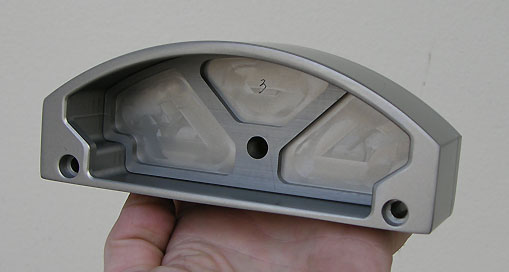
This
is the most sophisticated microprocessor based dash for
turbocharger
and supercharger use. Display is only approximately 6" wide by
2.5"
tall. A total of 45 leds and three buttons. Buttons are high
force,
easily activated, even wearing gloves. Hard anodized and
machined from
billet enclosure. Water resistant but not submersible.
Bench Testing Prior to
Installation
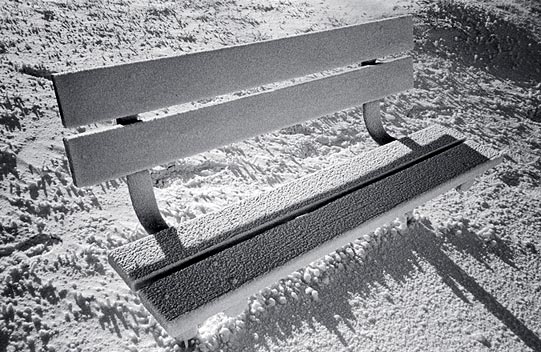
Whatever
nozzle and pump combination you choose you should bench test
the system
before you install it in your vehicle. Whenever we engineer
a new water
injection for one of our turbo kits we bench test the
delivery using
either digital flowmeters or simple burettes (100ml up to
2000ml).
Water is not hazardous, so all you need is a 12VDc power
source and
something to measure the flow. If you donít measure it you
will never
know. To simulate boost pressure we employ a pressure
regulator and a
gauge to accurately mimmick the delivery at different boost
levels.
Just flow water, and not water/alcohol, in
your
testing for obvious reasons.
For
you creative types you can use our nozzles both up and
downstream as
well as squirting water on your intercooler. It can get as
complicated
as you wish. Remember itís all a heat equation. Heat equals
power...but
too much heat equals destruction.
Time to get cold and wet. Those nozzles make a
mess.
DIY 
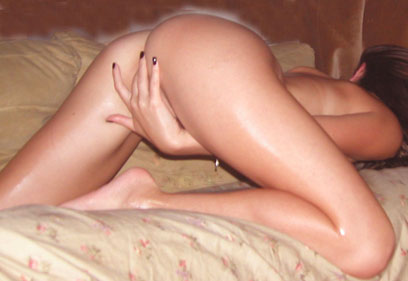
With
probably 100 individuals and half as many greedy capitalists
gathering up parts to make "kits" pushing
water into engines it's pretty easy to check around and put
together a
DIY Water Injection system for under well under $200.00. A
water pump
from Northern Tool
and a
bunch of parts from the hardware store and you can be a DIY
Water
Injection expert. Check around. All the information is easy to
come by.
DIY people call us up all the time...which is a
huge
waste of our time...i.e. telling them no... We do not sell
"Parts" so
they can do all sorts of dead end scenarios like:
1, Eight manifold nozles and 1 extra pre turbo.
2. Reservoir in front of a Porsche 911. Pump in
rear of car and six nozzles.
3. 2500hp Pro Gas methanol drag car with eight
nozzles.
4. "I have a water injection kit from Snow...I
have everything else but I want your pump"
5. "I want better fuel economy for my Cummins
Diesel semi."
Power Up
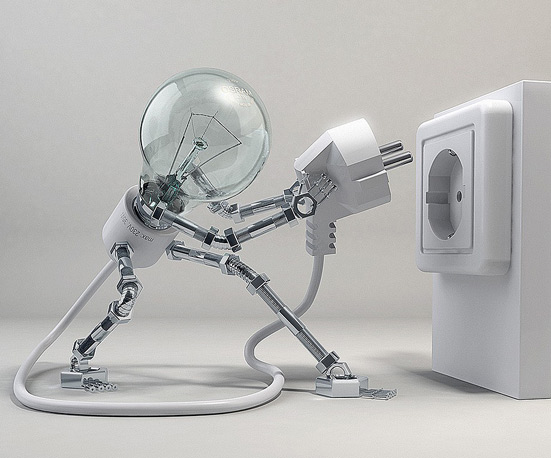
RB
Racing simply can't use the generic Shurflo systems as they
just aren't
suited for the motorcycle applications and racing that we do.
We tend to avoid
compromise and push the envelope. It's really a pain in the
ass to get
all the details worked out, especially when you are working
with 200
mph motorcycles that have little or no space to work with. Not
everyone
needs this level of sophistication and expense. We do.
Whatever you
decide to do, roll your own, or buy something, sooner or later
you have
to find out what she'll do. Power that thing up and stand on
it.
RSR Water Injection Calculator 
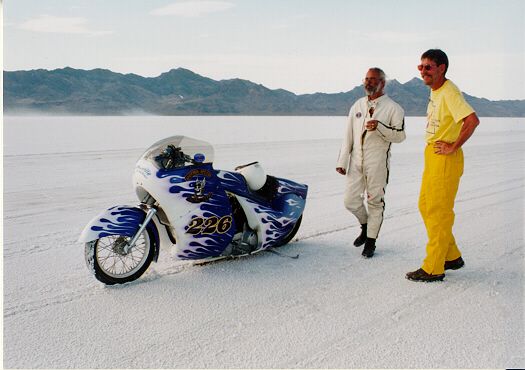
Mike Geokan's famous #226 Fuel Injected, Water Cooled,
Intercooled,
Turbo Harley Davidson with Water Injection. Bonneville record
holder.
RSR Pro 1000 PSI Turbo
Water
Injection Systems
RSR
Water InjectionPart
Number
|
CC's
Minute (CCM)
|
Nozzles
|
03-1001
|
160
|
Two "B" Nozzles
|
03-1002
|
180
|
One "D" Nozzle
|
03-1003
|
180
|
Two "A" Nozzles
|
03-1004
|
200
|
Two "C" Nozzles
|
03-1005
|
210
|
Three "A" Nozzles
|
03-1006
|
240
|
Two "D" Nozzles
|
03-1007
|
260
|
One "E" Nozzle
|
03-1008
|
280
|
One "G" Nozzle
|
03-1009
|
280
|
Two "E" Nozzles
|
03-1010
|
300
|
Two "F" Nozzles
|
Water Injection
Calculator
Maximum water
delivery
should be in higher load low to mid rpm
ranges tapering somewhat at peak rpms where load is less.Water
or Water
/ Alcohol to Fuel Ratios are between 12.5% to 25%. This means
Air to
Fluid Ratios are between 11.1:1 and 10.0:1 with water
injection. Enter
several horsepower figures for mid range and peak rpms. Use
our Boost and Airflow Calculator
to see what
your engine requires in boost to make a certain horsepower.
|
|
|
Bonneville and Street
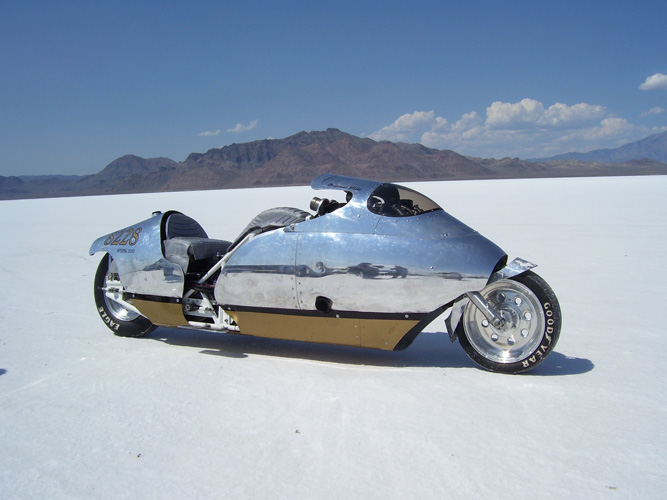
Do
we actually race this stuff? Well for the last 30
years the answer is
yes. All of our turbocharger
systems
and projects use
water injection.
Works for us. The bike above at moderate 19 psi of
boost and 345hp used
13% mo;ecular weight of the water injected versus
the fuel consumed
with 1000psi of nozzle pressure.
|







